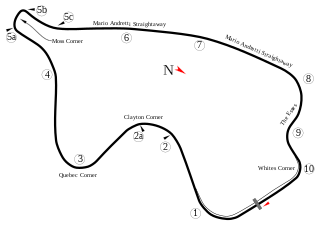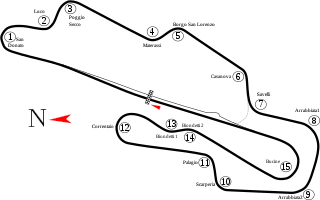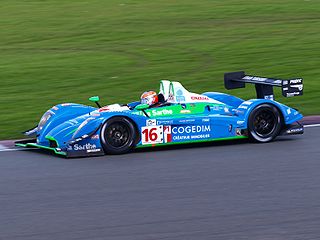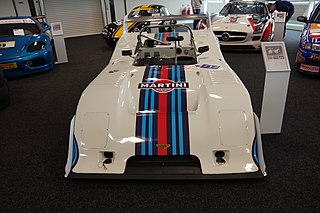Related Research Articles

Canadian Tire Motorsport Park is a multi-track motorsport venue located north of Bowmanville, in Ontario, Canada, 64-kilometre (40 mi) east of Toronto. The facility features a 3.957 km (2.459 mi), 10-turn road course; a 2.9 km (1.8 mi) advance driver and race driver training facility with a 0.402 km (0.250 mi) skid pad and a 1.5 km (0.93 mi) kart track. The name "Mosport", a portmanteau of Motor Sport, came from the enterprise formed to build the track.

Carlo Giovanni Facetti is a former racing driver from Italy, mainly known for his success in touring car and sports car racing. In his single attempt at Formula One he failed to qualify for the 1974 Italian Grand Prix with a Brabham BT42 run by the Scuderia Finotto team.

The Aston Martin DBR9 is a racing car built by Aston Martin Racing, debuting in 2005 and racing actively in international sportscar racing until the end of GT1 category in 2011. The name DBR9 is derived from the original 24 Hours of Le Mans-winning DBR1 car, named for then-owner David Brown, which not only won the 24 Hour race in 1959 but also the World Sportscar title. The car is most famous for taking two LMGT1 class wins at Le Mans 24 Hours by the Aston Martin Racing factory team.

The 1984 24 Hours of Le Mans was the 52nd Grand Prix of Endurance, and took place on 16 – 17 June 1984. It was also the third round of the 1984 World Endurance Championship. There were two big stories going into the race weekend: the absence of the Porsche works team and their drivers, and the return of Jaguar. Bob Tullius had commissioned the new Jaguar XJR-5 to run in the IMSA series and entered two for Le Mans. Earlier in the year, FISA had announced abrupt changes to the fuel regulations to bring them more in line with IMSA. Porsche and Lancia objected strongly because of their strong investment in the existing rules. In the absence of dominant Porsche works team, the race was left wide open between Lancia and the number of strong Porsche customer teams.

The 1983 24 Hours of Le Mans was the 51st Grand Prix of Endurance, which took place on 18 and 19 June 1983. It was also the fourth round of both the 1983 World Endurance Championship and European Endurance Championship. It was the 60th anniversary of the inaugural race in 1923

Mugello Circuit is a motorsport race track in Scarperia e San Piero, Florence, Tuscany, Italy. The circuit length is 5.245 km (3.259 mi). It has 15 turns and a 1.141 km (0.709 mi) long straight. The circuit stadium stands have a capacity of 50,000.
The 1984 World Sportscar Championship season was the 32nd season of FIA "World Sportscar Championship" motor racing. It featured the 1984 FIA World Endurance Championship, which was open to FIA Group C1, Group C2 and Group B cars and to IMSA GTP, GTX, GTO and GTU cars. The championship was contested over an eleven race series which ran from 23 April to 2 December 1984.

The Sauber SHS C6 was a Group C prototype racing car built by Swiss manufacturer Sauber and engineering firm Seger & Hoffman, intended for competition in the World Endurance Championship and Deutsche Rennsport Meisterschaft series. Seger & Hoffman left the project later in 1982, leaving the car completely under Sauber's control.

The Lancia LC2 was a series of racing cars built by Italian automobile manufacturer Lancia and powered by engines built by their sister company Ferrari. They were part of Lancia's official factory-backed effort in the World Sportscar Championship from 1983 to 1986, although they continued to be used by privateer teams until 1991. They were also the company's first car meeting the FIA's new Group C regulations for sports prototypes.

The 1985 Budweiser GT was the sixth round of the 1985 World Endurance Championship. Several teams from the Camel GT Championship also participated, under the GTP, GTO, and GTU classes. It took place at Mosport Park, Canada on August 11, 1985.

The Pescarolo 01 is the first sports prototype racing car built entirely by French team Pescarolo Sport. It is designed to meet the LMP1 and LMP2 regulations for Le Mans Prototypes in the Le Mans Series as well as at the 24 Hours of Le Mans, and replace Pescarolo's previous C60 chassis which had been heavily modified from cars purchased through Courage Compétition. The first 01s debuted at the 2007 1000 km of Monza.

Günter "Bobby" Klass was a versatile German racing driver, competing in hillclimbing, rallying, and the World Sportscar Championship as factory driver for Porsche and the Scuderia Ferrari.
Giannini Automobili S.p.A. is an Italian tuning company and a former producer of cars. Their focus has mainly been on Fiat cars. It was founded in 1920 by brothers Attilio and Domenico Giannini. The company headquarters are in Rome, Italy.
Giorgio Stirano is an Italian racing car engineer, who worked for Forti and Osella in Formula One.

The Chevron B31 was a sports prototype racing car built by Chevron Cars Ltd in 1975, and initially used in the European 2-Litre Championship. The car was an evolution of the Chevron B26, and was initially fitted with a 2-litre Hart 420R straight-four engine producing 290 hp. However, various other engines were used; the car also ran with engines such as the 3-litre Cosworth DFV V8, the 2-litre Cosworth FVD/Cosworth BDG straight-four engines, and the 2-litre BMW M12 straight-four, amongst others.
The Cheetah G603 was a Group C sports racing car built by Cheetah Automobiles in 1983. One car was built, and it was fitted with a 4-litre Cosworth DFL V8 engine; it had a short and fairly unsuccessful season before being replaced by the even less successful Cheetah G604 in 1984.
Martino Finotto was an Italian racing driver, mainly known for his success in touring car and sports car racing.

The Osella PA6 and Osella PA7 are Group 6 prototype racing car designed, developed, and built by Osella, to compete in the World Sportscar Championship sports car racing series between 1978 and 1982. It was powered by a number of different engines, including the 2.0 L (120 cu in) BMW M12/7 and the Cosworth BDG, and the 1.6 L (98 cu in) Cosworth FVA was also used. After retiring from sports car racing, these cars later competed in hillclimb racing.

The OSCA MT4, also spelled the O.S.C.A. MT4 or Osca MT4, is an Italian sports car prototype, designed, developed, and made by Officine Specializzata Costruzioni Automobili, between 1948 and 1956, but was raced and used in active competition until 1966.
The Alba AR6 was a Group C2 sports car prototype, designed, developed and built by Italian manufacturer Alba Engineering in 1985, to compete in the World Sportscar Championship, and used in sports car racing until 1990. A variant of the car, called the Alba AR8, was used in the IMSA GTP Championship.
References
- ↑ "Alba AR2". Archived from the original on 2016-03-14. Retrieved 2022-06-17.
- ↑ "Group C: The Rise and Fall of the Golden Age of Endurance Racing: Cars and Constructors Part 1". Motorsport Retro. 20 February 2019. Archived from the original on 2021-03-05. Retrieved 2022-06-17.
- ↑ "1983 Alba AR2 Giannini - Images, Specifications and Information". Ultimatecarpage.com. Archived from the original on 2021-08-11. Retrieved 2022-06-17.
- ↑ "Alba AR2-Giannini". Archived from the original on 2022-06-18. Retrieved 2022-06-17.
- ↑ "Silverstone 1983". Archived from the original on 2022-03-22. Retrieved 2022-06-17.
- ↑ "Nurburgring 1983". Archived from the original on 2022-03-23. Retrieved 2022-06-17.
- ↑ "F2 Register - Index". www.devontophotels.com. Archived from the original on 2016-03-04. Retrieved 2022-06-17.
- ↑ "Spa 1983". Archived from the original on 2022-03-22. Retrieved 2022-06-17.
- ↑ "Fuji 1983". Archived from the original on 2022-03-22. Retrieved 2022-06-17.
- ↑ "Imola 1983". Archived from the original on 2021-11-23. Retrieved 2022-06-17.
- ↑ "Brands Hatch 1983". Archived from the original on 2022-03-22. Retrieved 2022-06-17.
- ↑ "Kyalami 1983". Archived from the original on 2022-03-22. Retrieved 2022-06-17.
- ↑ "Monza 1984". Archived from the original on 2022-03-22. Retrieved 2022-06-17.
- ↑ "Mugello 1985". Archived from the original on 2022-03-23. Retrieved 2022-06-17.
- ↑ "Miami 1986". Archived from the original on 2022-04-07. Retrieved 2022-06-17.
- ↑ "Mosport 1995". Archived from the original on 2021-12-09. Retrieved 2022-06-17.